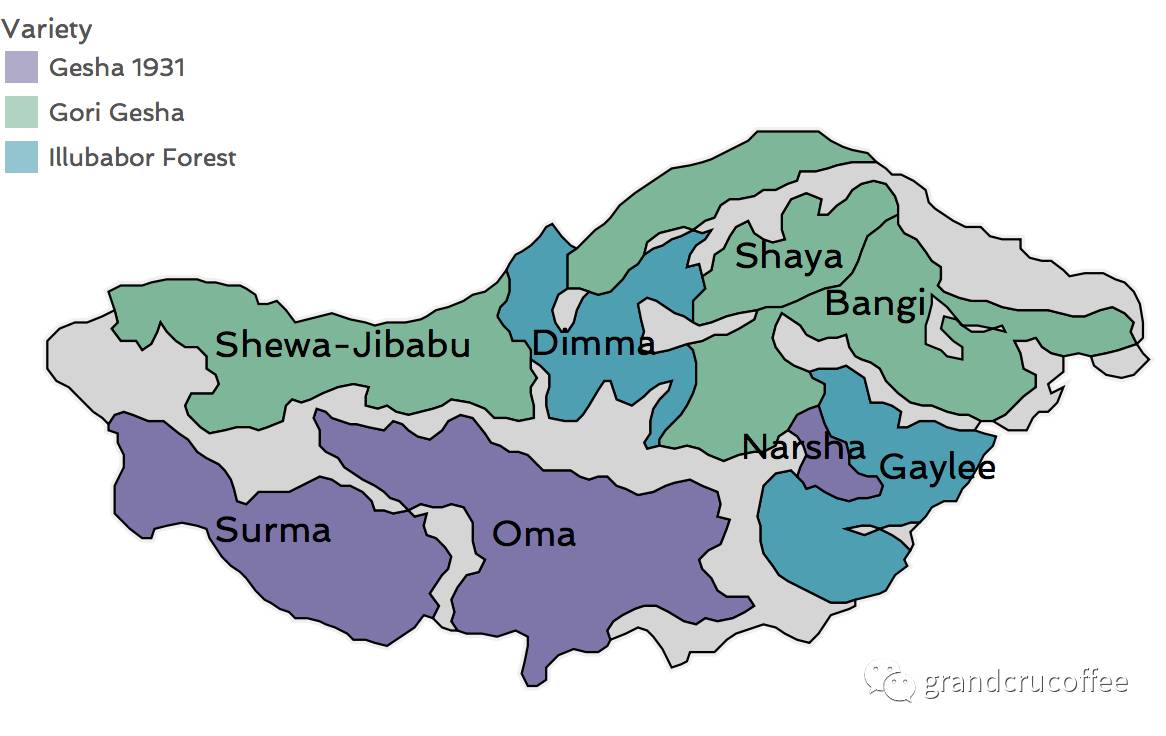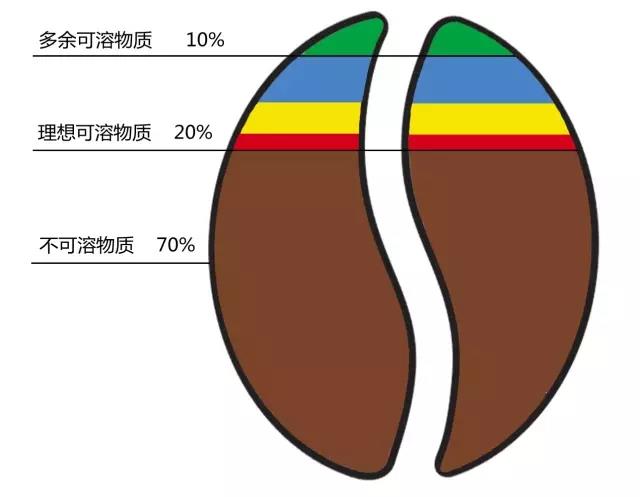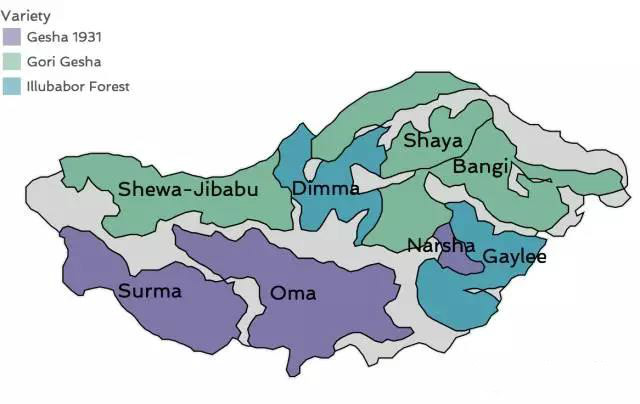About the background of Rose Xia Village Coffee Manor
What is the difference between going to Dixixia Village and an ordinary Ethiopian manor? What do OMA and SURMA refer to in the batch number? What does the series of numbers 51, 72 and 59 mean? What's the difference between Gesha1931 and Gori Gesha?
Next, the editor will give you answers one by one.
Manor background
Adam Overton and Samuel Rachel have been growing Ethiopian Rose Summer in nearly 500 hectares of Rosa Village since 2011, and their sole goal is to produce the best coffee in the world. Since 2008, after three years of searching, they have finally found an environmental system suitable for coffee growth in 1900-2100 meters high altitude, with tropical rain forest, suitable climate, fertile forest soil and long history of forest.
The coffee farm in Ruoxia Village has a total area of 471 hectares, and 300 hectares of coffee has been planted in 2015, with an increase of 50 hectares in 2016. Rosa was selected from the native coffee forest (Gori Gesha), 20 kilometers from the manor, which is where the Panamanian variety came from. With the help of Mr. Willem Boot, the godfather of Rosa, the coffee in Rosa Village has won many good results in the world competition.
Strong traceability and high quality control
Unlike most Ethiopian coffee, it needs to be exported through ECX (Ethiopian Commodity Exchange) or cooperatives. Because of its size of nearly 500 hectares, Ruoxia Village Coffee Manor can be treated and exported independently as a single manor. Therefore, it has traceability unmatched by other Ethiopian raw beans.
Each batch of raw beans can be traced back to its specific plot, variety, tree age, picking date, sun (washing) treatment time and other links, effectively ensuring the transparency of each link and the possibility of quality control.
What is the difference between Gori Gesha and Gesha1931?
Gori Gesha and Gesha 1931 all refer to the name of the variety planted.
Three varieties were planted in Guoxia Village, namely, Gori Gesha, Gesha 1931 and Illubabor Forest. The first two varieties are Rosa rugosa, while Illubabor Forest is a disease-resistant variety provided by the Ethiopian Research Institute.
Among them, Gori Gesha is a rose variety from the wild coffee forest Gori Gesha near the manor, which covers the genetic diversity of Rosa, so it is named after the forest.
Gesha 1931 is selected from several rose summer varieties in Gori Gesha forest, which is closest to Panama rose summer. The selection of varieties depends on the shape of coffee plant, the appearance of coffee beans and the results of cup test. It is also named Gesha 1931 because 1931 was the year in which the rose variety was discovered from Ethiopia.
What do OMA, SURMA, etc. Represent?
The manor is divided into nearly 500 hectares of land according to different varieties and microclimate (as shown in the following figure):
Therefore, the distribution of varieties is as follows:
Planting Gori Gesha: Shewa-Jibabu; Shaya, Bangi
Planting Gesha 1931: Surma; Oma; Narsha
Planting Illubabor Forest: Dimma; Gaylee
What is the meaning of the number in the batch name?
At this time, we should start to talk specifically about the traceability of Rose Xia Village.
Picking date data of partial batches from 2016 to 2017 in Guoxia Village (figure: bidding information of Guoxia Village)
Take the sunburn batch of the OMA plot of Japanese champion Guizhiro Ishitani as an example (see picture above). The planting variety of the plot is Gesha 1931, and the interior of the plot is divided into five sun batches of 51, 72, 77, 86 and 90. The closer the area is, the closer the maturity and picking period is. In addition, OMA#27 is an one-to-one washing batch for the site (the location is limited, which is not shown in the picture above). The competition bean of Shigu Gui is a competitive lot of OMA#51, and one of the batches ordered by Grand Cru Coffee is the same batch of OMA#72.
After many cup tests and screening, Grand Cru Coffee selected three distinct sun batches and purchased them in batches, of which the first batch of Surma#85 and Shewa-Jibabu#59 has been sold out; the second batch of replenishment Shewa-Jibabu#59 the same batch, Oma#72 the same batch of spot supply.
The specific cup test flavor is as follows:
1 Shewa-Jibabu#59 same batch (Gori Gesha)
The batch has outstanding sweetness, obvious strawberry, peach, papaya and other flavors, and the flower smell is delicate and the taste is as rich as cream.
2 Oma#72 in the same batch (Gesha 1931)
This batch is sugar-soaked fruit with strong floral aroma and high complexity.
The above two batches of Rosa rugosa were treated by solarization. First remove the floating impurities, and then cover the African-style elevated scaffolding with film and plastic sheet. the total drying time is 18-30 days.

Plot division of Ruoxia village & schematic map of variety planting (photo: official publicity materials of Guoxia village)
Important Notice :
前街咖啡 FrontStreet Coffee has moved to new addredd:
FrontStreet Coffee Address: 315,Donghua East Road,GuangZhou
Tel:020 38364473
- Prev

Coffee extraction rate, coffee soluble matter, extraction rate and TDS complete
Once the water enters the coffee cells, it begins to dissolve the soluble substances in them. When fully dissolved, the solution formed by water and these soluble substances is known as coffee, but not all soluble substances are good. Only 30% of coffee beans are soluble in water, and the remaining 70% are insoluble in fiber and carbohydrates. 30% when
- Next

What is the difference between Rose Summer Village and ordinary Ethiopian Manor Rose Summer?
For the exchange of professional baristas, please pay attention to the difference between the coffee workshop (Wechat official account cafe_style) to Diroxia Village and the average Ethiopian manor. What do OMA and SURMA refer to in the batch number? What does the series of numbers 51, 72 and 59 mean? What's the difference between Gesha1931 and Gori Gesha? Next, the editor will give you answers one by one. Manor background
Related
- Beginners will see the "Coffee pull flower" guide!
- What is the difference between ice blog purified milk and ordinary milk coffee?
- Why is the Philippines the largest producer of crops in Liberia?
- For coffee extraction, should the fine powder be retained?
- How does extracted espresso fill pressed powder? How much strength does it take to press the powder?
- How to make jasmine cold extract coffee? Is the jasmine + latte good?
- Will this little toy really make the coffee taste better? How does Lily Drip affect coffee extraction?
- Will the action of slapping the filter cup also affect coffee extraction?
- What's the difference between powder-to-water ratio and powder-to-liquid ratio?
- What is the Ethiopian local species? What does it have to do with Heirloom native species?

